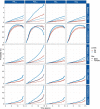Ambient air pollution associated with incidence and dynamic progression of type 2 diabetes: a trajectory analysis of a population-based cohort
- PMID: 36310158
- PMCID: PMC9620670
- DOI: 10.1186/s12916-022-02573-0
Ambient air pollution associated with incidence and dynamic progression of type 2 diabetes: a trajectory analysis of a population-based cohort
Abstract
Background: Though the association between air pollution and incident type 2 diabetes (T2D) has been well documented, evidence on the association with development of subsequent diabetes complications and post-diabetes mortality is scarce. We investigate whether air pollution is associated with different progressions and outcomes of T2D.
Methods: Based on the UK Biobank, 398,993 participants free of diabetes and diabetes-related events at recruitment were included in this analysis. Exposures to particulate matter with a diameter ≤ 10 μm (PM10), PM2.5, nitrogen oxides (NOx), and NO2 for each transition stage were estimated at each participant's residential addresses using data from the UK's Department for Environment, Food and Rural Affairs. The outcomes were incident T2D, diabetes complications (diabetic kidney disease, diabetic eye disease, diabetic neuropathy disease, peripheral vascular disease, cardiovascular events, and metabolic events), all-cause mortality, and cause-specific mortality. Multi-state model was used to analyze the impact of air pollution on different progressions of T2D. Cumulative transition probabilities of different stages of T2D under different air pollution levels were estimated.
Results: During the 12-year follow-up, 13,393 incident T2D patients were identified, of whom, 3791 developed diabetes complications and 1335 died. We observed that air pollution was associated with different progression stages of T2D with different magnitudes. In a multivariate model, the hazard ratios [95% confidence interval (CI)] per interquartile range elevation in PM2.5 were 1.63 (1.59, 1.67) and 1.08 (1.03, 1.13) for transitions from healthy to T2D and from T2D to complications, and 1.50 (1.47, 1.53), 1.49 (1.36, 1.64), and 1.54 (1.35, 1.76) for mortality risk from baseline, T2D, and diabetes complications, respectively. Generally, we observed stronger estimates of four air pollutants on transition from baseline to incident T2D than those on other transitions. Moreover, we found significant associations between four air pollutants and mortality risk due to cancer and cardiovascular diseases from T2D or diabetes complications. The cumulative transition probability was generally higher among those with higher levels of air pollution exposure.
Conclusions: This study indicates that ambient air pollution exposure may contribute to increased risk of incidence and progressions of T2D, but to diverse extents for different progressions.
Keywords: Air pollution; Diabetes complication; Diabetes mortality; Multi-state model; Type 2 diabetes.
© 2022. The Author(s).
Conflict of interest statement
The authors declare they have no competing interests.
Figures



References
-
- Saeedi P, Petersohn I, Salpea P, Malanda B, Karuranga S, Unwin N, et al. Global and regional diabetes prevalence estimates for 2019 and projections for 2030 and 2045: Results from the International Diabetes Federation Diabetes Atlas, 9(th) edition. Diabetes Res Clin Pract. 2019;157:107843. doi: 10.1016/j.diabres.2019.107843. - DOI - PubMed
Publication types
MeSH terms
Substances
Grants and funding
LinkOut - more resources
Full Text Sources
Medical

